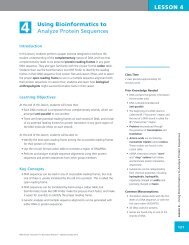WET LAB DNA Barcoding: From Samples to Sequences - Northwest ...
WET LAB DNA Barcoding: From Samples to Sequences - Northwest ...
WET LAB DNA Barcoding: From Samples to Sequences - Northwest ...
Create successful ePaper yourself
Turn your PDF publications into a flip-book with our unique Google optimized e-Paper software.
<strong>WET</strong> <strong>LAB</strong><br />
CLASS SET<br />
Lab 4: Preparation of PCR <strong>Samples</strong><br />
for <strong>DNA</strong> Sequencing<br />
Student Researcher Background:<br />
What is PCR Purification and Why Do We Need To Do It?<br />
If your PCR reaction was successful, the next step is <strong>to</strong> perform PCR<br />
purification: removal of all of your PCR ingredients, leaving only your <strong>DNA</strong><br />
<strong>to</strong> be sequenced by a <strong>DNA</strong> sequencing facility. If your PCR ingredients were<br />
left in with your <strong>DNA</strong> sample, they would interfere with the PCR reaction<br />
performed for the <strong>DNA</strong> sequencing (described below). PCR purification is<br />
very similar <strong>to</strong> <strong>DNA</strong> purification: the <strong>DNA</strong> binds <strong>to</strong> a spin column containing<br />
a <strong>DNA</strong>-binding membrane, and all other components are washed away<br />
before the <strong>DNA</strong> is eluted from the spin column.<br />
Sanger sequencing: A method<br />
of <strong>DNA</strong> sequencing that uses<br />
deoxyribonucleaotides (dNTPs)<br />
and dideoxyribonucleotide<br />
triphosphates (ddNTPs). The<br />
ddNTPs end <strong>DNA</strong> synthesis<br />
at random positions, and the<br />
resulting fragments can be<br />
analyzed <strong>to</strong> determine the exact<br />
<strong>DNA</strong> sequence.<br />
What is <strong>DNA</strong> Sequencing?<br />
<strong>DNA</strong> sequencing is the process of determining the exact order of the nucleotide bases—adenine (A), thymine (T),<br />
guanine (G), and cy<strong>to</strong>sine (C)—in a particular piece of <strong>DNA</strong>. This is often performed at <strong>DNA</strong> sequencing facilities<br />
by labora<strong>to</strong>ry technicians who are trained <strong>to</strong> work with the large machines necessary for this procedure. Sanger<br />
sequencing is a method of <strong>DNA</strong> sequencing used by many genetic researchers <strong>to</strong>day, and is very similar in many<br />
ways <strong>to</strong> the polymerase chain reaction that you performed.<br />
PART I: PCR Purification<br />
1. Add 80 μl of <strong>DNA</strong> binding Buffer (labeled “Buffer”) <strong>to</strong> the microfuge tube labeled “PCR” from Lab 3 that<br />
contains the remaining 40 µl of your PCR product.<br />
[Note: Do not purify your Negative Control.]<br />
2. Place one spin column in a no-cap collection tube.<br />
3. Label the lid of the spin column with your name or initials.<br />
4. Transfer the approximately 120 μl of your PCR + <strong>DNA</strong> Binding Buffer sample <strong>to</strong> the spin column. Be careful<br />
when handling the spin column and no-cap collection tube, as the two are not attached <strong>to</strong> one another.<br />
5. Close the lid of the spin column and centrifuge (or “spin”) your sample at 10,000 rpm for one minute.<br />
[Note: If your centrifuge doesn’t go as fast as 10,000 rpm, centrifuge on maximum speed for 5 minutes.]<br />
6. Add 200 of μl Wash Buffer (labeled “Wash”) <strong>to</strong> your spin column.<br />
7. Centrifuge your sample at 10,000 rpm for one minute.<br />
[Note: If your centrifuge doesn’t go as fast as 10,000 rpm, centrifuge on maximum speed for 5 minutes.]<br />
8. Discard the flow-through from your no-cap collection tube and put your spin column back in the no-cap<br />
collection tube.<br />
9. Add another 200 μl of Wash Buffer (labeled “Wash”) <strong>to</strong> your spin column.<br />
10. Centrifuge your sample again at 10,000 rpm for one minute.<br />
Wet Lab – <strong>DNA</strong> <strong>Barcoding</strong>: <strong>From</strong> <strong>Samples</strong> <strong>to</strong> <strong>Sequences</strong><br />
[Note: If your centrifuge doesn’t go as fast as 10,000 rpm, centrifuge on maximum speed for 5 minutes.]<br />
363<br />
©<strong>Northwest</strong> Association for Biomedical Research—Updated Oc<strong>to</strong>ber 2012
















